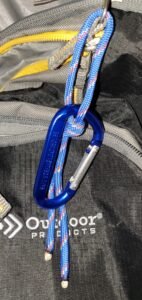Ounce Counting: How Much Does Your Hiking Bag Weigh?
Ounce Counting: How Much Does Your Hiking Bag Weigh?
How much does your carabiner weigh? You may be thinking “Is she serious? Does she really weigh carabiners?”
I can hear the questions rolling around and see the looks on your faces. While I actually do not do this, it is pretty close to how nitpicky ounce counters can get.
For those that are not familiar, let’s briefly discuss ounce counting. Outdoor adventurers who ounce count cut as much weight from their packs as possible. They consider the weight of EVERY single item that they carry. This means the bag itself, food, first aid, sleeping bag, sleeping pad, clothes, flashlight, knife, tent, trekking poles, tarp, etc. Every piece of gear is weighed to achieve minimal pack weight.
Did you weigh that?
The type of people weighing their packs are generally going to be your backpackers. They are hiking their gear to the spot they are going to camp at. The duration of this outdoor adventure may be days to months. Everything has to be with you at all times.
It is extremely important that you are carrying a light bag rather than something that weighs 40+ pounds on a trip that covers more than 10 miles and can reach over 2000 miles. Your day bag should not exceed 10% of your own body weight and your backpacking bag should not exceed 20% of your weight.
Who Should Weigh Gear?
Extreme ounce counting may not be for everyone. However, it can be beneficial to all types of adventures to keep a weight limit on packs and gear. No one wants a heavy bag for a day hike, it is tiring and can shorten your trip.
If you are kayaking with gear, kayaks have weight limits. You need to keep in mind your body weight plus your gear weight. You will want your gear to be light to stay under max capacity.
Light gear typically makes camping more enjoyable as well. Hauling items to and from your vehicle is less taxing. Who wants to put all that heavy stuff in the car in the morning after enjoying a relaxing trip anyway?

Keeping Essentials
Remember, keeping a light pack doesn’t mean you can toss out the essentials. Don’t ever skip on safety to make your pack lighter. Do your research to find out what items can be dual use such as a whistle that is also a compass or a knife with a flint stone for a fire striker.
There are so many brands out there now that focus on lightweight gear. So you shouldn’t have much of a struggle replacing your heavier items.
Build your own first aid kit. They often don’t include everything you need as it is. This is an opportunity to make sure you aren’t lugging around things that won’t actually save you.
Also think outside the box and know your landscape. Let’s say you are hiking in an area that is guaranteed to have water. You might consider making a swap for carrying less water overall and utilizing some type of water purification system.
I impress the importance of knowing your terrain when doing this. There will always be a potential of there not being water no matter how well you know a place. Remember, you hike at your own risk. Make sure you do your due diligence if you are going to be making gear swaps such as this.
One can never stress enough, Know Before You Go.

Start Ounce Counting Now
Counting ounces on your gear from the start will save you energy and keep fatigue down. I’ll be honest, this tactic can get expensive. Keep in mind, it will cost less in the long run. Imagine changing your mind down the road and having to buy all your gear a second time but in a lighter version….been there and my wallet is not happy about it.
You don’t have to be as meticulous as a backpacker, but contemplate the gear you need and think about lightening your load. Take advantage of the knowledge that counting ounces will make your life easier. Enjoy Your Adventure!
If you want more outdoor tips, go join the Facebook Group LivLifeOutdoors and add a post with your questions.
If you’d like to check out my adventures, Follow me on IG @livlifeoutdoors for more content.

Author
liv@livlifeoutdoors.com
Related Posts
How to Shop for Hiking Boots
How to Shop for Hiking Boots Your hiking boots are the most essential piece of gear you own – carrying you over...
Read out allChoosing the Right Gear: What to Wear When Hiking
Choosing the Right Gear: What to Wear When Hiking When you’re just starting out, figuring out what to wear on a hike...
Hiking Footwear – My Feet Tested Them, So You Don’t Have to!
Still afraid to buy your first pair of hiking footwear? My feet tested out a few for you. Hiking Footwear – My...
What no one will tell you when shopping for hiking footwear.
Stuck on nature It is your first time hiking. You are marveling at the height of the trees reaching upwards in to...
Read out all
